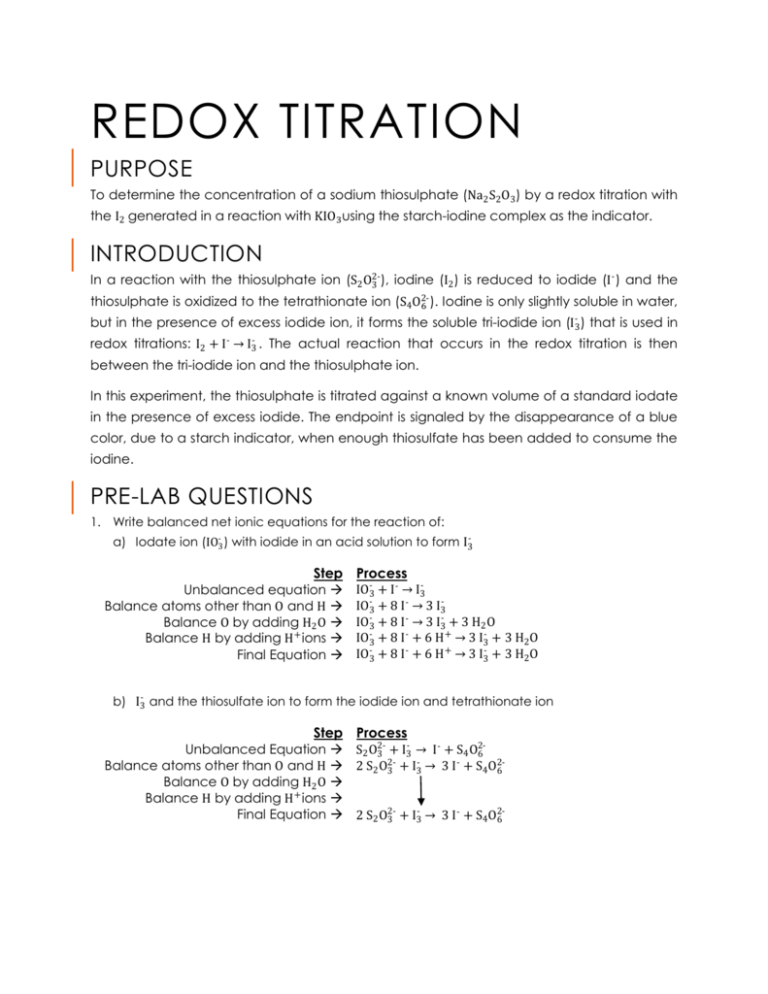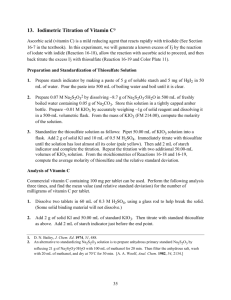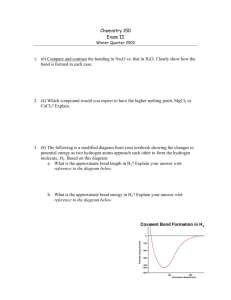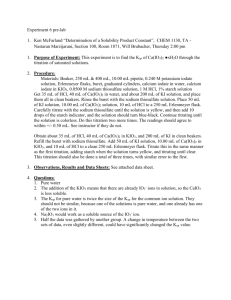REDOX TITRATION - ChemBlog Inc
advertisement

REDOX TITRATION PURPOSE To determine the concentration of a sodium thiosulphate (Na2 S2 O3) by a redox titration with the I2 generated in a reaction with KIO3using the starch-iodine complex as the indicator. INTRODUCTION In a reaction with the thiosulphate ion (S2 O23 ), iodine (I2 ) is reduced to iodide (I ) and the thiosulphate is oxidized to the tetrathionate ion (S4 O26 ). Iodine is only slightly soluble in water, but in the presence of excess iodide ion, it forms the soluble tri-iodide ion (I3- ) that is used in redox titrations: I2 + I- → I3- . The actual reaction that occurs in the redox titration is then between the tri-iodide ion and the thiosulphate ion. In this experiment, the thiosulphate is titrated against a known volume of a standard iodate in the presence of excess iodide. The endpoint is signaled by the disappearance of a blue color, due to a starch indicator, when enough thiosulfate has been added to consume the iodine. PRE-LAB QUESTIONS 1. Write balanced net ionic equations for the reaction of: a) Iodate ion (IO-3 ) with iodide in an acid solution to form I3- Step Unbalanced equation Balance atoms other than O and H Balance O by adding H2 O Balance H by adding H+ ions Final Equation Process IO-3 + I - → I3IO-3 + 8 I- → 3 I3IO-3 + 8 I- → 3 I3- + 3 H2 O IO-3 + 8 I- + 6 H+ → 3 I3- + 3 H2 O IO-3 + 8 I- + 6 H+ → 3 I3- + 3 H2 O b) I3- and the thiosulfate ion to form the iodide ion and tetrathionate ion Step Unbalanced Equation Balance atoms other than O and H Balance O by adding H2 O Balance H by adding H+ ions Final Equation Process 2S2 O23 + I3 → I + S4 O6 22 S2 O3 + I3 → 3 I + S4 O26 22 S2 O23 + I3 → 3 I + S4 O6 2. Calculate the concentration of an iodate solution that contains 1.9853 g of KIO3 in a 1000 mL volumetric flask. Steps Find the number of moles of KIO3 are in 1.9853 g. Process 1.9853 g nKIO3 = 214 g/mol nKIO3 ≅0.00928 𝑚𝑜𝑙 Calculate a molar ratio of iodate ions in KIO3 . 𝐾+ IO-3 1 1 = 0.00928 mol x 0.00928 mol = x Use the formula 𝐶𝑜𝑛𝑐𝑒𝑛𝑡𝑟𝑎𝑡𝑖𝑜𝑛 = calculate the concentration. 𝑀𝑜𝑙 𝑉𝑜𝑙𝑢𝑚𝑒 (𝐿) to C= n V C= 0.00928 mol 1L C = 9.28 × 10-3 mol/L 3. Calculate the molar concentration of a thiosulfate solution given that 25.00 mL of 0.0195 mol/L KIO3 solution in a flask containing 2.00 g of KI and 10 mL of 0.500 mol/L H2 SO4 required 34.81 mL of thiosulfate solution to reach the starch endpoint. Reaction Between IO-3 and I- IO-3 + 8 I- + 6 H+ → 3 I3- + 3 H2 O Mol of IO-3 reacted = 0.00049 mol Number of mol of I3- released = 3 × 0.00049 𝑚𝑜𝑙 = 0.00147 𝑚𝑜𝑙 𝐶KIO3 = 𝑛KIO3 𝑉KIO3 0.0195 𝑀 = 𝑛KIO3 0.025𝐿 0.00049 𝑚𝑜𝑙 = 𝑛KIO3 Reaction Between I- and S2 O23 22 S2 O23 + I3 → 3 I + S4 O6 1 mol of I3 reacts with 2 mol of S2 O23 2 × 0.00147 𝑚𝑜𝑙 = 0.00294 𝑚𝑜𝑙 Concentration of S2 O2solution 0.08 mol/L 3 C= n V C= 0.00294 mol 0.0348 L C ≅ 0.08 mol/L DEFINITIONS Titration The precise addition of a solution in a burette into a measured volume of a sample solution Titrant The solution in a burette during a titration End Point The point in a titration at which a sharp change in a measurable and characteristic property occurs (usually a color change) Equivalence Point The measured quantity of a titrant recorded at the point at which chemically equivalent amounts have reacted Burette A graduated tube of glassware that has a stopcock at its bottom end It is used to dispense precise volumes of liquid reagents MATERIALS KIO3 (aq)______ M Erlenmeyer flasks Na2S2O3 solution Beakers graduated cylinders 0.5 M H2SO4 solution wash bottle burets and clamps solid KI distilled water balance retort stand starch solution PROCEDURE 1. Assemble the equipment. 2. Pipette 25.0 mL of the standard KIO3 solution into a flask. Add 2.000 g of solid KI and 10 mL of 0.500 mol/L H2 SO4 to the flask 3. Properly fill a burette with the thiosulfate solution. 4. Titrate with the thiosulfate until the solution has lost its reddish-brown color and has become orange. 5. Add 2 mL of starch indicator and complete the titration. 6. Note the initial and final burette readings to at least one decimal place. 7. Repeat the titrations at least twice more until the concentration of the thiosulfate agrees to within 10%. OBSERVATIONS Concentration of KIO3 _4.305g/2L 0.01 mol/L_ Na2 S2 O3 Final Burette Reading (mL) Initial Burette Reading (mL) Volume Used (mL) Rough 19.0 0.0 19.0 Trial #1 21.0 0.0 21.0 Trial #2 40.8 21.0 19.8 Trial #3 46.6 25.0 21.6 CALCULATIONS 1. What is the concentration of KIO3? The concentration of KIO3was 0.01M 2. Write the balanced equation for the reaction between iodate and iodide ions (see pre-lab) Step Unbalanced equation Balance atoms other than O and H Balance O by adding H2 O Balance H by adding H+ ions Final Equation Process IO-3 + I - → I3IO-3 + 8 I- → 3 I3IO-3 + 8 I- → 3 I3- + 3 H2 O IO-3 + 8 I- + 6 H+ → 3 I3- + 3 H2 O IO-3 + 8 I- + 6 H+ → 3 I3- + 3 H2 O 3. Calculate the moles of iodate used in each titration and the moles of I3- produced in each reaction with the iodate ion. 𝐶IO3 = 𝑛IO3 𝑉KIO3 0.01 𝑀 = 𝑛IO3 0.025 𝐿 IO-3 + 8 I- + 6 H+ → 3 I3- + 3 H2 O For every 1 IO-3 ion, 3 I3- are produced. Therefore, 3×0.00025 mol of IO-3 =0.00075mol of I3- produced 0.00025 𝑚𝑜𝑙 = 𝑛IO3 4. Write the equation for the reaction of the tri-iodide ion and the thiosulfate ion (see pre-lab) Step Unbalanced Equation Balance atoms other than O and H Balance O by adding H2 O Balance H by adding H+ ions Final Equation Process 2S2 O23 + I3 → I + S4 O6 22 S2 O3 + I3 → 3 I + S4 O26 22 S2 O23 + I3 → 3 I + S4 O6 5. Calculate the moles of thiosulfate in each titration and the concentration of the thiosulfate solution. 22 S2 O23 + I3 → 3 I + S4 O6 21 mol of I3- reacts with 2 mol of S2 O23 0.00075 mol of I3 × 2 = 0.0015 mol of S2 O3 Trial # Rough 1 2 3 Moles of S2 O23 (mol) 0.0015 0.0015 0.0015 0.0015 Volume of S2 O23 used (L) 0.0190 0.0210 0.0198 0.0216 Concentration of S2 O23 (mol/L) 0.093 0.084 0.089 0.082









